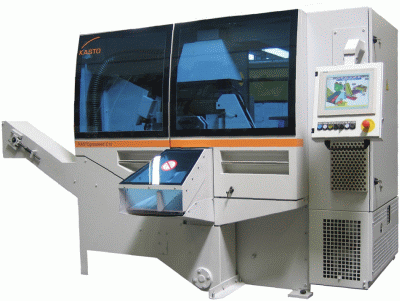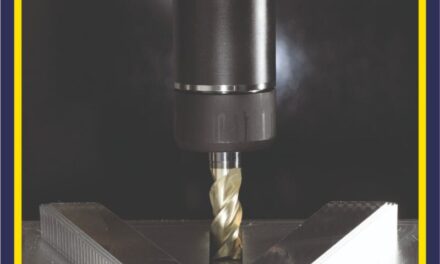 German sawing machine builder, Kasto, recently delivered a turnkey production process to a bearing manufacturer for cutting off short lengths of stock from thick-walled, 100Cr6 steel tube of 677N/mm² tensile strength to produce bearing race blanks. It was a particularly exacting circular sawing application, provided by Kasto’s UK subsidiary
German sawing machine builder, Kasto, recently delivered a turnkey production process to a bearing manufacturer for cutting off short lengths of stock from thick-walled, 100Cr6 steel tube of 677N/mm² tensile strength to produce bearing race blanks. It was a particularly exacting circular sawing application, provided by Kasto’s UK subsidiary
The high strength, through hardening, drawn steel tube has an outside diameter of 80.84mm, a wall thickness of 18.80mm and has to be cut into 30.30mm long pieces. It follows that an area of 36.6cm² is sawn during each cut. Length tolerance and squareness of cut are fairly open at ± 0.2mm and 0.4mm respectively.
However, other potential users in the same industry require closer length tolerance as well as parallelity and squareness values that demand a process capability of Cmk (capability machine index) better than 1.76. As a rule of thumb, this is halved to achieve the required tolerances.
Meeting demands
The mass production circular saw, KASTOgripspeed, was the machine chosen to fulfill the demanding task. It has a narrow, distortion-free welded construction and a base filled with mineral concrete to minimise vibration, leading to good surface finish and long blade life. It is fully enclosed and is operated via a touchscreen control.
The saw blade is fed into the tube on linear guides at an angle of 25 degrees, which offers best performance in terms of burr-free cutting, regardless of material cross section. The saw blade itself is guided by three pairs of large carbide plates. Other features are a frequency-controlled 11kW drive, play-free gears, a material magazine and a ballscrew driven gripper to ensure accurate positioning of the material.
Due to the interrupted cutting conditions experienced by the saw teeth as they enter the bore of the thick-walled tubes, the sawn faces are prone to picking up vibration marks and blades tend to wear faster than when processing solid bar.
 Vacuum unit
Vacuum unit
To minimise these effects by avoiding chips collecting inside the tube, from where they can be dragged through the kerf by the blade during sawing, Kasto installed a system to vacuum the swarf continuously from the bore. This also has the effect of reducing the noise generated by sawing.
The compact vacuum unit is mounted on the cut side of the tube. The suction technique completely evacuates the chips and is effective for cut lengths up to approximately 300mm.
Efficient saw blades
When sawing tubes as opposed to solid material, due to the interrupted cutting it is recommended that a saw blade with a larger number of teeth is used, i.e. a fine tooth pitch from 10 to 15mm. When cutting heavy wall tubes, the correct pitch should have a few teeth constantly engaged in the material to help guide the blade.
Thin-cut, TiN-coated saw blades with a thickness of 2.25mm and a kerf of 2.5mm were tested, along with others. Particularly in the case of short cut pieces, thin-cut saw blades are the standard for mass production due to minimisation of material loss, so the KASTOgripspeed is designed for their use. Saw blades with a diameter of 360mm and from 80 to 100 teeth were identified as being the most efficient, which equates to a tooth pitch of between 14.14mm and 11.31mm.
Suitable values for feed per tooth (fz) are between 0.05mm to 0.1mm. For this application, a cutting speed of 170m/min and a saw infeed rate of 902mm/min gives an fz of 0.06mm to 0.07mm, which corresponds to a cutting time of 5.8 seconds and a cycle time of 8.8 seconds per cut. Blade lifetime is 28.69m². Minimum lubrication is standard for high performance cutting of tubes, as flood coolant evaporates due to the high cutting temperatures.
Minimising cleaning
Another advantage of having the vacuum unit is that there are no chips covering the sawn pieces as they fall down a chute into a sorting unit, which in turn keeps the bearing race blank containers largely free from unwanted swarf. As a result, minimal cleaning is needed before the components proceed to the next production step.
Kasto states that the extra cost of fitting the swarf suction unit is quickly amortised by longer blade life and longer intervals between blade change.




